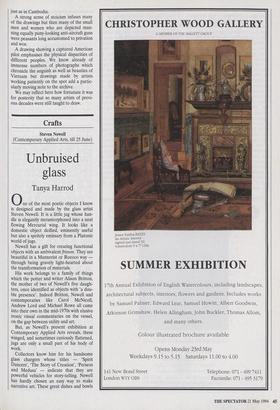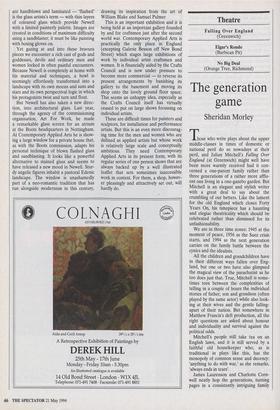Crafts
Steven Newell
(Contemporary Applied Arts, till 25 June)
Unbruised glass
Tanya Harrod
One of the most poetic objects I know is designed and made by the glass artist Steven Newell. It is a little jug whose han- dle is elegantly metamorphosed into a neat flowing Mercurial wing. It looks like a domestic object deified, eminently useful but also a spritely emissary from a Platonic world of jugs.
Newell has a gift for creating functional objects with an ambivalent frisson. They are beautiful in a Mannerist or Rococo way — through being gravely light-hearted about the transformation of materials.
His work belongs to a family of things which the potter and writer Alison Britton, the mother of two of Newell's five daugh- ters, once identified as objects with 'a dou- ble presence'. Indeed Britton, Newell and contemporaries like Carol McNicoll, Andrew Lord and Michael Rowe all came into their own in the mid-1970s with elusive ironic visual commentaries on the vessel, on the gap between utility and art.
But, as Newell's present exhibition at Contemporary Applied Arts reveals, these winged, and sometimes curiously flattened, jugs are only a small part of his body of work.
Collectors know him for his handsome glass chargers whose titles — 'Spirit Dancers', 'The Story of Creation', 'Perseus and Medusa' — indicate that they are powerful vehicles for story-telling. Newell has hardly chosen an easy way to make narrative art. These great dishes and bowls are handblown and laminated — 'flashed' is the glass artists's term — with thin layers of coloured glass which provide Newell with a limited painterly palette. Images are created in conditions of maximum difficulty using a sandblaster; it must be like painting with boxing gloves on.
Yet gazing at and into these bravura pieces we encounter a rich cast of gods and goddesses, devils and ordinary men and women locked in often painful encounters. Because Newell is completely at home with his material and techniques, a bowl is seemingly effortlessly transformed into a landscape with its own moons and suns and stars and its own perspectival logic in which his protagonists twist and turn and float.
But Newell has also taken a new direc- tion, into architectural glass. Last year, through the agency of the commissioning organisation, Art For Work, he made a remarkable glass screen for an atrium at the Boots headquarters in Nottingham. At Contemporary Applied Arts he is show- ing a large window for a private house that, as with the Boots commission, adapts his personal technique of blown flashed glass and sandblasting. It looks like a powerful alternative to stained glass and seems to have released a new mood in Newell. Stur- dy angelic figures inhabit a pastoral Edenic landscape. The window is unashamedly part of a neo-romantic tradition that has run alongside modernism in this century,
drawing its inspiration from the art of William Blake and Samuel Palmer
This is an important exhibition and it is being held at an important gallery founded by and for craftsmen just after the second world war. Contemporary Applied Arts is practically the only place in England (excepting Galerie Besson off New Bond Street) which stages large exhibitions of work by individual artist craftsmen and women. It is financially aided by the Crafts Council and is now under pressure to become more commercial — to reverse its present arrangements by banishing its gallery to the basement and moving its shop onto the lovely ground floor space. This seems an unhappy idea, especially as the Crafts Council itself has virtually ceased to put on large shows focussing on individual artists.
These are difficult times for painters and sculptors, for installation and performance artists. But this is an even more discourag- ing time for the men and women who are defined as applied artists but whose work is relatively large scale and conceptually ambitious. They need Contemporary Applied Arts in its present form, with its regular series of one person shows that are always backed up by a well illustrated leaflet that sets sometimes inaccessible work in context. For them, a shop, howev- er pleasingly and attractively set out, will hardly do.





































































 Previous page
Previous page